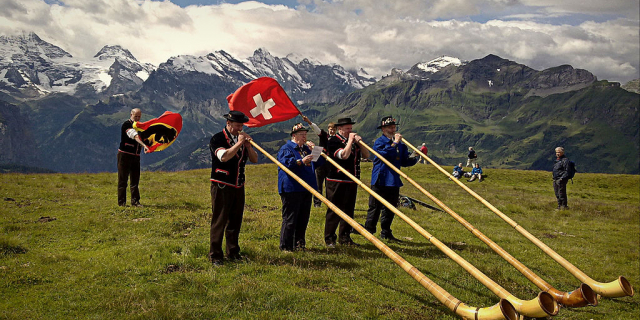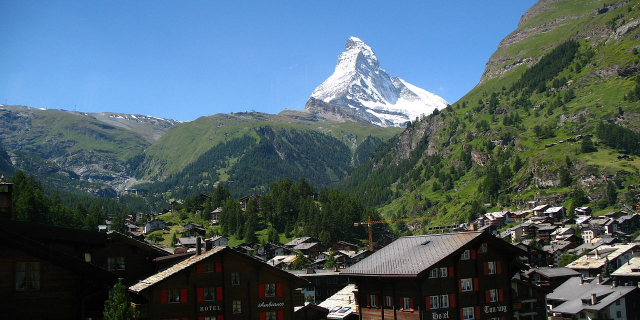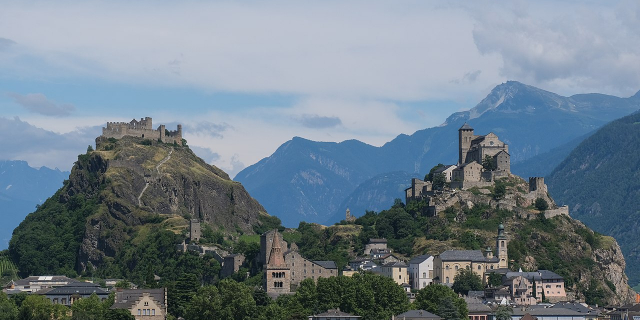The Matterhorn (German: [ˈmatɐˌhɔʁn] , Swiss Standard German: [ˈmatərˌhɔrn]; Italian: Cervino [tʃerˈviːno]; French: Cervin [sɛʁvɛ̃]; Romansh: Mont(e) Cervin(u)) is a mountain of the Alps, straddling the main watershed and border between Italy and Switzerland. It is a large, near-symmetric pyramidal peak in the extended Monte Rosa area of the Pennine Alps, whose summit is 4,478 metres (14,692 ft) above sea level, making it one of the highest summits in the Alps and Europe. The four steep faces, rising above the surrounding glaciers, face the four compass points and are split by the Hörnli, Fur...Read more
The Matterhorn (German: [ˈmatɐˌhɔʁn] , Swiss Standard German: [ˈmatərˌhɔrn]; Italian: Cervino [tʃerˈviːno]; French: Cervin [sɛʁvɛ̃]; Romansh: Mont(e) Cervin(u)) is a mountain of the Alps, straddling the main watershed and border between Italy and Switzerland. It is a large, near-symmetric pyramidal peak in the extended Monte Rosa area of the Pennine Alps, whose summit is 4,478 metres (14,692 ft) above sea level, making it one of the highest summits in the Alps and Europe. The four steep faces, rising above the surrounding glaciers, face the four compass points and are split by the Hörnli, Furggen, Leone/Lion, and Zmutt ridges. The mountain overlooks the Swiss town of Zermatt, in the canton of Valais, to the northeast; and the Italian town of Breuil-Cervinia in the Aosta Valley to the south. Just east of the Matterhorn is Theodul Pass, the main passage between the two valleys on its north and south sides, which has been a trade route since the Roman Era.
The Matterhorn was studied by Horace-Bénédict de Saussure in the late eighteenth century, and was followed by other renowned naturalists and artists, such as John Ruskin, in the 19th century. It remained unclimbed after most of the other great Alpine peaks had been attained and became the subject of an international competition for the summit. The first ascent of the Matterhorn was in 1865 from Zermatt by a party led by Edward Whymper, but during the descent, a sudden fall claimed the lives of four of the seven climbers. This disaster, later portrayed in several films, marked the end of the golden age of alpinism. The north face was not climbed until 1931 and is among the three biggest north faces of the Alps, known as "The Trilogy". The west face, the highest of the Matterhorn's four faces, was completely climbed only in 1962. It is estimated that over 500 alpinists have died on the Matterhorn, making it one of the deadliest peaks in the world.
The Matterhorn is mainly composed of gneisses (originally fragments of the African Plate before the Alpine orogeny) from the Dent Blanche nappe, lying over ophiolites and sedimentary rocks of the Penninic nappes. The mountain's current shape is the result of cirque erosion due to multiple glaciers diverging from the peak, such as the Matterhorn Glacier at the base of the north face. Sometimes referred to as the Mountain of Mountains (German: Berg der Berge), it has become an indelible emblem of the Alps in general. Since the end of the 19th century, when railways were built in the area, the mountain has attracted increasing numbers of visitors and climbers. Each year, numerous mountaineers try to climb the Matterhorn from the Hörnli Hut via the northeast Hörnli ridge, the most popular route to the summit. Many trekkers also undertake the 10-day-long circuit around the mountain. The Matterhorn has been part of the Swiss Federal Inventory of Natural Monuments since 1983.
Aegidius Tschudi, one of the earliest Alpine topographers and historians, was the first to mention the region around the Matterhorn in his work, De Prisca ac Vera Alpina Raethi, published in Basel in 1538. He approached the Matterhorn as a student when in his Alpine travels he reached the summit of the Theodul Pass but he does not seem to have paid any particular attention to the mountain itself.[1]
 Theodulpass, c. 1800
Theodulpass, c. 1800The Matterhorn remained unstudied for more than two centuries, until a geologist from Geneva, Horace Benedict de Saussure, travelled to the mountain, which filled him with admiration. However, de Saussure was not moved to climb the mountain, and had no hope of measuring its altitude by taking a barometer to its summit. "Its precipitous sides," he wrote, "which give no hold to the very snows, are such as to afford no means of access." Yet his scientific interest was kindled by "the proud peak which rises to so vast an altitude, like a triangular obelisk, that seems to be carved by a chisel." His mind intuitively grasped the causes which gave the peak its present precipitous form: the Matterhorn was not like a perfected crystal; the centuries had laboured to destroy a great part of an ancient and much larger mountain. On his first journey de Saussure had come from Ayas to the Col des Cimes Blanches, from where the Matterhorn first comes into view; descending to Breuil, he ascended to the Theodul Pass. On his second journey, in 1792, he came to the Valtournanche, studying and describing it; he ascended to the Theodul Pass, where he spent three days, analysing the structure of the Matterhorn, whose height he was the first to measure, and collecting stones, plants and insects. He made careful observations, from the sparse lichen that clung to the rocks to the tiny but vigorous glacier fly that fluttered over the snows and whose existence at such heights was mysterious. At night he took refuge under the tent erected near the ruins of an old fort at the top of the pass. During these days he climbed the Klein Matterhorn (3,883 metres), which he named the Cime Brune du Breithorn.[1]
The first inquirers began to come to the Matterhorn. There is a record of a party of Englishmen who in the summer of 1800 crossed the Great St. Bernard Pass, a few months after the passage of Bonaparte; they came to Aosta and thence to Valtournenche, slept at the chalets of Breuil, and traversed the Theodul Pass, which they called Monte Rosa. The Matterhorn was to them an object of the most intense and continuous admiration.[1]
 The Matterhorn by Edward Theodore Compton, 1879
The Matterhorn by Edward Theodore Compton, 1879The Matterhorn is mentioned in a guide-book to Switzerland by Johann Gottfried Ebel, which was published in Zürich towards the end of the eighteenth century, and translated into English in 1818. The mountain appeared in it under the three names of Silvius, Matterhorn, and Mont Cervin, and was briefly described as one of the most splendid and wonderful obelisks in the Alps. On Zermatt there was a note: "A place which may, perhaps, interest the tourist is the valley of Praborgne (Zermatt); it is bounded by huge glaciers which come right down into the valley; the village of Praborgne is fairly high, and stands at a great height above the glaciers; its climate is almost as warm as that of Italy, and plants belonging to hot countries are to be found there at considerable altitudes, above the ice."[1]
William Brockedon, who came to the region in 1825, considered the crossing of the Theodul Pass from Breuil to Zermatt a difficult undertaking. He gave, however, expression to his enthusiasm on the summit. When he arrived exhausted on the top of the pass, he gazed "on the beautiful pyramid of the Cervin, more wonderful than aught else in sight, rising from its bed of ice to a height of 5,000 feet, a spectacle of indescribable grandeur." In this "immense natural amphitheatre, enclosed from time immemorial by snow-clad mountains and glaciers ever white, in the presence of these grand walls the mind is overwhelmed, not indeed that it is unable to contemplate the scene, but it staggers under the immensity of those objects which it contemplates."
Those who made their way up through the Valtournanche to the foot of the mountain were few in number. W. A. B. Coolidge, a diligent collector of old and new stories of the Alps, mentions that during those years, besides Brockedon, only Hirzel-Escher of Zürich, who crossed the Theodul Pass in 1822, starting from Breuil, accompanied by a local guide. The greater number came from the Valais up the Visp valley to Zermatt. In 1813, a Frenchman, Henri Maynard, climbed to the Theodul Pass and made the first ascent of the Breithorn; he was accompanied by numerous guides, among them J. M. Couttet of Chamonix, the same man who had gone with de Saussure to the top of the Klein Matterhorn in 1792. The writings of these pioneers make much mention of the Matterhorn; the bare and inert rock is gradually quickened into life by men's enthusiasm. "Stronger minds," remarked Edward Whymper, "felt the influence of the wonderful form, and men who ordinarily spoke or wrote like rational beings, when they came under its power seemed to quit their senses, and ranted and rhapsodised, losing for a time all common forms of speech."[1]
Among the poets of the Matterhorn during these years (1834 to 1840) were Elie de Beaumont, a famous French geologist; Pierre Jean Édouard Desor, a naturalist of Neuchâtel, who went up there with a party of friends, two of whom were Louis Agassiz and Bernhard Studer. Christian Moritz Engelhardt, who was so filled with admiration for Zermatt and its neighbourhood that he returned there at least ten times (from 1835 to 1855), described these places in two valuable volumes, drew panoramas and maps, and collected the most minute notes on the mineralogy and botany of the region. Zermatt was at that time a quiet little village, and travellers found hospitality at the parish priest's, or at the village doctor's.[1]
 The Matterhorn by John Ruskin, 1849
The Matterhorn by John Ruskin, 1849In 1841 James David Forbes, professor of natural philosophy at the University of Edinburgh, came to see the Matterhorn. A philosopher and geologist, and an observant traveller, he continued the work of De Saussure in his journeys and his writings. He was full of admiration for the Matterhorn, calling it the most wonderful peak in the Alps, unsealed and unscalable. These words, pronounced by a man noted among all his contemporaries for his thorough knowledge of mountains, show what men's feelings then were towards the Matterhorn, and how at a time when the idea of Alpine exploration was gaining ground in their minds, the Matterhorn stood by itself as a mountain apart, of whose conquest it was vain even to dream. And such it remained till long after this; as such it was described by John Ball twenty years later in his celebrated guide-book. Forbes ascended the Theodul Pass in 1842, climbed the Breithorn, and came down to Breuil; as he descended from the savage scenery of the Matterhorn, the Italian landscapes of the Valtournanche seemed to him like paradise. Meanwhile, Gottlieb Samuel Studer, the geographer, together with Melchior Ulrich, was describing and mapping the topographical features of the Zermatt peaks.[1][2]
Rodolphe Töpffer, who first accompanied and guided youth to the Alps for purposes of education and amusement, began his journeys in 1832, but it is only in 1840 that he mentions the Matterhorn. Two years later Töpffer and his pupils came to Zermatt. He has described this journey of his in a chapter entitled Voyage autour du Mont Blanc jusqu'à Zermatt, here he sings a hymn of praise to the Matterhorn, comparing its form with a "huge crystal of a hundred facets, flashing varied hues, that softly reflects the light, unshaded, from the uttermost depths of the heavens". Töpffer's book was illustrated by Alexandre Calame, his master and friend, with drawings of the Matterhorn, executed in the romantic style of the period. It is an artificial mountain, a picture corresponding rather with the exaggerated effect it produces on the astonished mind of the artist, than with the real form of the mountain.[1]
About this time there came a man who studied the Matterhorn in its structure and form, and who sketched it and described it in all its parts with the curiosity of the artist and the insight of the scientist. This was John Ruskin, a new and original type of philosopher and geologist, painter and poet, whom England was enabled to create during that period of radical intellectual reforms, which led the way for the highest development of her civilisation. Ruskin was the Matterhorn's poet par excellence. He went to Zermatt in 1844, and it is to be noticed as a curious fact, that the first time he saw the Matterhorn it did not please him. The mountain on its lofty pedestal in the very heart of the Alps was, perhaps, too far removed from the ideal he had formed of the mountains; but he returned, studied and dreamt for long at its feet, and at length he pronounced it "the most noble cliff in Europe." Ruskin was no mountaineer, nor a great friend to mountaineering; he drew sketches of the mountains merely as an illustration of his teaching of the beauty of natural forms, which was the object of his whole life. In his work on Modern Painters he makes continual use of the mountains as an example of beauty and an incentive to morality. The publication of Ruskin's work certainly produced a great impression at the time on educated people in England, and a widespread desire to see the mountains.[1]
It is a fragment of some size; a group of broken walls, one of them overhanging; crowned with a cornice, nodding some hundred and fifty feet over its massive flank, three thousand above its glacier base, and fourteen thousand above the sea, — a wall truly of some majesty, at once the most precipitous and the strongest mass in the whole chain of the Alps, the Mont Cervin.[1]
 Aerial photography by Eduard Spelterini in 1910
Aerial photography by Eduard Spelterini in 1910Other men of high attainments followed, but in the years 1850 scientists and artists were about to be succeeded by real climbers and the passes and peaks around Zermatt were explored little by little. In the preface to the first volume of the Alpine Journal, which appeared in 1863, the editor Hereford Brooke George wrote that: "While even if all other objects of interest in Switzerland should be exhausted, the Matterhorn remains (who shall say for how long?) unconquered and apparently invincible." Whymper successfully reached the summit in 1865, but four men perished on the descent. The English papers discussed it with bitter words of blame; a German newspaper published an article in which Whymper was accused of cutting the rope between Douglas and Taugwalder, at the critical moment, to save his own life.[1]
 View of The Matterhorn from Gornergrat Railway
View of The Matterhorn from Gornergrat RailwayIn 1890 the Federal Government was asked simultaneously by the same contractor for a concession for the Zermatt-Gornergrat railway, and for a Zermatt-Matterhorn one. The Gornergrat railway was constructed in 1896-1898 and has been working since August 1898, but there has been no more talk of the other. The project essentially consisted of a line which went up to the Hörnli, and continued thence in a rectilinear tunnel about two kilometres long, built under the ridge, and issuing near the summit on the Zmutt side.[1] Sixty years later in 1950, Italian engineer Count Dino Lora Totino planned a cable car on the Italian side from Breuil-Cervinia to the summit. But the Alpine Museum of Zermatt sent a protest letter with 90,000 signatures to the Italian government. The latter declared the Matterhorn a natural wonder worthy of protection and refused the concession to the engineer.[3]
2015 marked the 150th anniversary of the first ascent. Events and festivities were held throughout the year. A completely renewed Hörnli Hut opened the same year in the month of July.[4][5]
In 2020, during the COVID-19 pandemic, light artist Gerry Hofstetter started projecting country flags and messages of endurance onto the mountain peak as part of a nightly series designed to show support and spread hope for everyone suffering and those fighting the pandemic.[6]

































Add new comment